GIGABYTE BRIX Pro: A First Look at the Intel i7-4770R with Iris Pro HD 5200
by Ganesh T S on January 7, 2014 8:00 PM EST
Gigabyte is targeting the BRIX Pro towards professional consumers with compute-intensive workloads. For general office use (including web browsing and light word processing work), systems such as the Core i5-based NUC we reviewed last week are more than enough. In order to bring out scenarios where the extra grunt provided by the Pro unit becomes necessary, we are presenting some real world benchmarks below. These are tasks carried out by workers where time in money, and the premium paid upfront for the better configuration is trivial compared to the time saved.
WinRAR Benchmark
We present two benchmarks using WinRAR. The first one involves decompressing a 4.36 GB split archive and recording the time taken to complete the process. This is a test of the CPU power as well as the storage subsystem.
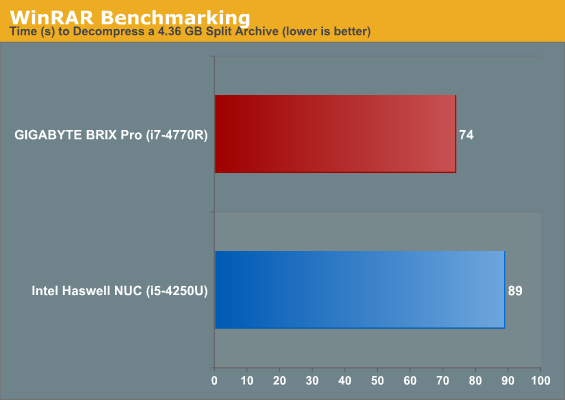
The graph below presents the internal WinRAR benchmark numbers. In this benchmark, the program takes compresses / decompresses random data in the RAM. This is a test of the CPU power as well as the DRAM capabilities.
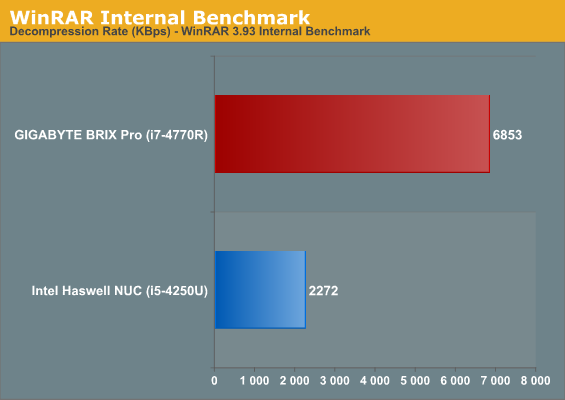
TrueCrypt Benchmark
As businesses (and even home consumers) become more security conscious, the importance of encryption can't be overstated. CPUs supporting the AES-NI instruction for accelerating the encryption and decryption processes have, till now, been the higher end SKUs. However, with Bay Trail, even the lowly Atom series has gained support for AES-NI. Both the i5-4250U and the i7-4770R have AES-NI instructions support. The TrueCrypt internal benchmark provides some interesting cryptography-related numbers to ponder. In the graph below, we can get an idea of how fast a TrueCrypt volume would behave in the two different systems.
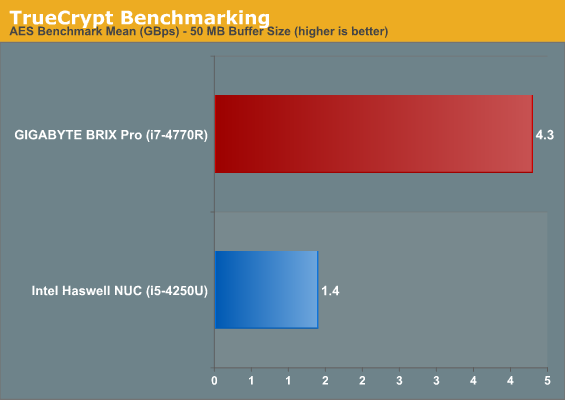
Agisoft PhotoScan
Agisoft PhotoScan is a commercial program that converts 2D images into 3D point maps, meshes and textures. The program designers sent us a command line version in order to evaluate the efficiency of various systems that go under our review scanner. The command line version has two benchmark modes, one using the CPU and the other using both the CPU and GPU (via OpenCL). The benchmark takes around 50 photographs and does four stages of computation:
Stage 1: Align Photographs
Stage 2: Build Point Cloud (capable of OpenCL acceleration)
Stage 3: Build Mesh
Stage 4: Build Textures
We record the time taken for each stage. Since various elements of the software are single threaded, others multithreaded, and some use GPUs, it is interesting to record the effects of CPU generations, speeds, number of cores, DRAM parameters and the GPU using this software.
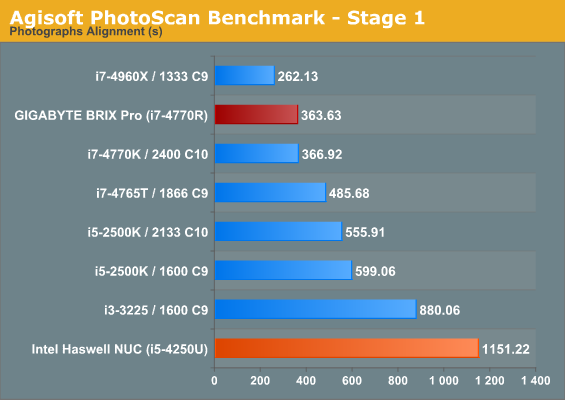
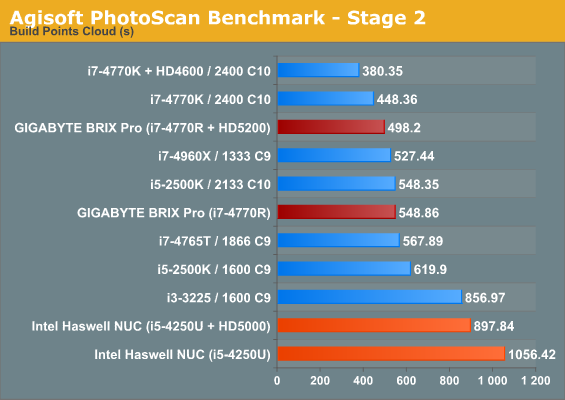

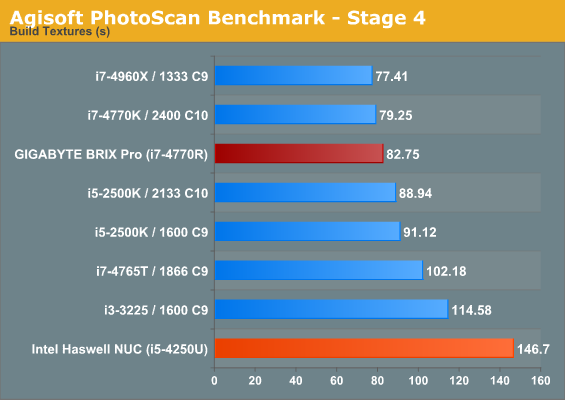
The second stage also reports the throughput rate of the CPU and GPU in million points per second. For the BRIX Pro, in the CPU only mode, we had a rate of 124.99 mp/s. Using OpenCL acceleration, the CPU and GPU had rates of 69.5 mp/s and 98.32 mp/s respectively. The corresponding numbers for the NUC were 68.36 mp/s, 20.39 mp/s and 78.59 mp/s.
Essentially a prosumer real-world test, we hope to put more of our systems under this benchmark in the future. Ian already has a large number of custom-built systems for which he will present benchmarks in his motherboard reviews.










98 Comments
View All Comments
gochichi - Tuesday, January 7, 2014 - link
As was mentioned in the Mac Pro 2013 review, the desktop market needs to evolve to remain viable and relevant. While it’s nice to see these NUC systems finally start popping up, I feel like the price just isn’t right for these new systems. They are clearly as inexpensive to make as a traditional system and so I don’t understand the prices. Shipping costs from China of these tiny machines should represent some sort of savings to the manufacturer.I’d like to see something actually forward looking come from the PC side. Like a standard external power supply unit that is as standard as ATX PSUs are today. I like the thing, it doesn’t have to have the best design on the planet but the price is just so off. $1000 for why? We’re not even accounting for a Windows OS (and maybe we shouldn’t, Linux is actually viable) but still, Windows is another bill. I get that we could find an mSATA drive for $90 but still, it is just slow progress. I feel like if it’s cheap to make (which this thing obviously is), I’d love to see that reflected on the price on day one.
Let me put it another way… I’d like to see a standard that is more or less a laptop without an embedded keyboard, mouse or screen or battery. I see so many laptops that I think, “If this didn’t have this crappy screen, if this had NO screen at all” I’d buy it and use it for X. I see $230 laptops with Windows installed and the only problem I see with them is that they are laptops. I know the screens, keyboard and trackpads and batteries on lower end laptops are junk, but are they really next-to-free to include?
Looking at the shape of things, it is genius on Apple’s side to make the device circular in order to follow the shape of the gigantic fan. If we boil down the essence of what a desktop is, we say: BIGGER fans= bigger thermal capacity, bring your own monitor, keyboard, and mouse.
The Microsoft Store carries exactly zero desktops. Now it’s nice to see what I want become available at all, but it seems strange that it would come at a huge price premium. Apple continues to lead in terms of value and in terms of understand the market (and I find this very frustrating, I wish I could just get my Apple tattoo and “switch” and be done with it, but I keep rooting for open standards that never come.
Call it Ultradesk (vs Ultrabook), I think we’re so fantastically overdue a real update on desktops and this device is one that probably after 3-years you’ll be glad you didn’t look at the price at all but at the same time, the same could be said about a Mac Mini.
I’m talking about a Microsoft Surface minus the touchscreen and battery… just plain desktop in a quiet and versatile format.
JohnHardkiss - Tuesday, January 7, 2014 - link
Totally agree with you, +1.Qwertilot - Wednesday, January 8, 2014 - link
Desktops do definitely need to sort themselves out. I'm not sure if they should to go outright cheap mind.Desktops have such a long fully usable life span now - even gaming will give you ~5 years and it could be much more for other uses - so there's arguably actually more incentive than before to get everything 'nice'. Not in power terms as such but monitor, keyboard, form factor, noise etc.
CknSalad - Wednesday, January 8, 2014 - link
There just needs to be less full and mid-tower PCs and a lot more M-ATX (Silverstone TJ08-E sized) and especially ITX cases like the crowd-funded Ncase M1, SG05 or the antec ISK series (for the less-demanding tasks). I totally agree that the desktop market has been way too slow into moving towards the SFF market.artemisgoldfish - Tuesday, January 7, 2014 - link
A single eSATA port would be really nice. USB 3.0 is nice and all, but it's just not as compelling as a storage interface. Other than that nit to pick, I think the lesser Gigabyte units would make nice low-power home servers once you connect external bulk storage, and the higher-specced units... Well, I would quite like one in my cubicle at work.ryrynz - Tuesday, January 7, 2014 - link
Wanna see options for making this thing near silent.ryrynz - Tuesday, January 7, 2014 - link
Any chance of looking into how underclocking and swapping out the fan helps with noise?ryrynz - Tuesday, January 7, 2014 - link
Can you look into what options are available in the BIOS too?Zandros - Tuesday, January 7, 2014 - link
Interesting total power consumption numbers and as a proof of concept. 88 W compares with Apple's stated 85 W max (actual power seems to be significantly less though) for the Mac mini. I really think the R-series could work well in a redesigned mini, if only to avoid the exorbitant prices of the mobile Iris Pro parts. Sadly, the list price of the 4570R is still about $50 higher than the current Ivy Bridge in the low end mini.mofo77 - Wednesday, January 8, 2014 - link
It seems to be a great combination of size and power but one thing is really disappointing, i.e. mini DP max resolution is 3200x2000 instead of 4k (according to specification found on the Gigabyte web page). It is a huge omission in my opinion. I almost wanted to order this unit but because of that I will not do that. The other consideration is noise. I want my PC to run as quiet as possible.